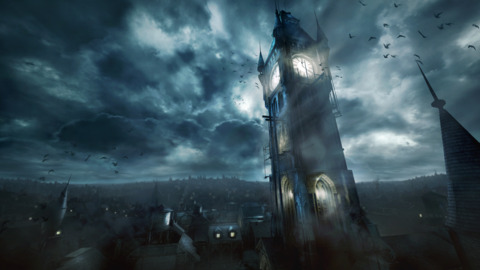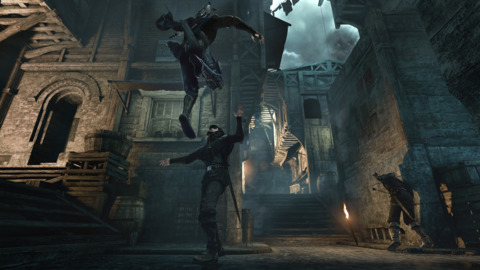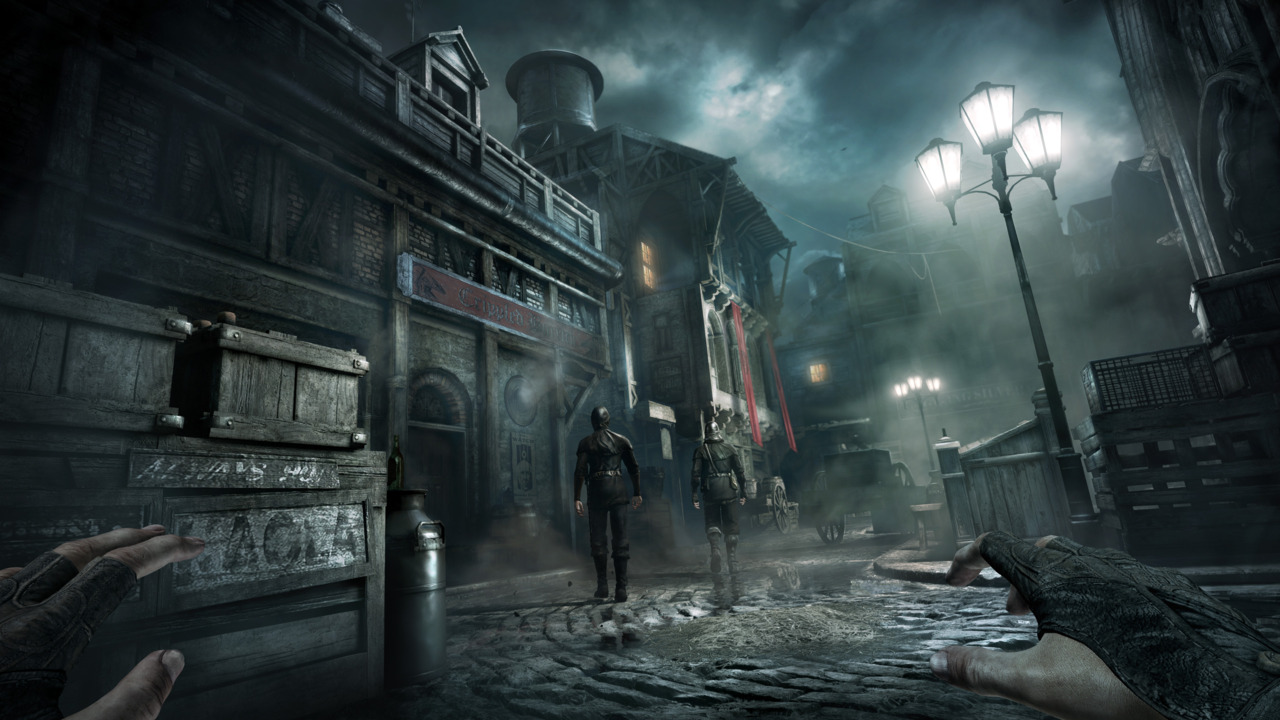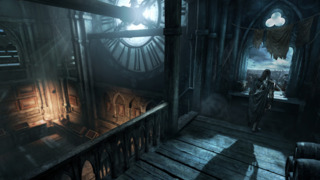The lights went down and the man spoke.
His baritone echoed through the room as his energy rose and fell, passionately telling the somber tale of master thief Garrett and his protege Erin. Where Garrett was silent and precise, Erin grew reckless and bloodthirsty. Where Garrett understood that chaos is to be avoided, Erin reveled in creating it. Yet Garrett was drawn to the girl. Like him, she was a child of the streets, once forced to scrub floors in the local whorehouse before escaping into the cold darkness of The City.
In time, however, Garrett grew increasingly aggravated with Erin's refusal to find solace in the shadows. He allowed her to go her separate way, though he never forgot her. Years later, it was this fond memory that arsonist friend Basso exploited to reunite the two. Basso sent Garrett on a thieving mission--but Erin was already on the scene. Garrett was reticent to join the young woman on this quest for riches, but he was certain she must have grown, must have left her brutal ways behind.
Another Crab's Treasure Is A Soulslike 3D Platformer | GameSpot Review Stellar Blade Review Nintendo 64 – April 2024 Game Updates – Nintendo Switch Online Super Monkey Ball Banana Rumble - Official Multiplayer Features Trailer PUBG | Erangel Classic Returns Gori: Cuddly Carnage | Meow Launch Date Announcement Trailer Genshin Impact - "Arlecchino: Afterglow of Calamity" | Collected Miscellany Marvel Rivals - Official Loki Character Reveal Trailer | The King of Yggsgard Fortnite Festival - Official Billie Eilish Cinematic Season 3 Trailer Remnant 2 - The Forgotten Kingdom | DLC Launch Trailer Stellar Blade - Official "The Journey: Part 2" Behind The Scenes Trailer | PS5 Games Dead by Daylight | Tome 19: Splendor | Reveal Trailer
Please enter your date of birth to view this video
By clicking 'enter', you agree to GameSpot's
Terms of Use and Privacy Policy
How wrong he was. Garrett watched Erin as she used her signature claw for killing purposes as well as for grappling to higher ground. She was no longer a thief but a sloppy assassin who held little respect for the lives of others. Where Garrett killed only when necessary, Erin killed for fun. And so Garrett swiped the claw when Erin was otherwise occupied, hoping to teach her a lesson.
Erin never lived to learn the lesson. When the building supporting them crumbled beneath them, Erin dropped to her death, powerless to save herself with the claw no longer in her possession. Garrett, too, tumbled to the ground and fell into blackness. A year later he awoke, the time lost, and the political events that led to The City's descent into its current despair a mystery. And so there was only one thing to do: find Basso.
Light returned to the room. This portion of Garrett's dark story, as melodramatically recounted by Thief narrative director Steven Gallagher, was finished. But the full tale was far from over.
The first time I saw Thief in action some months ago, I watched it being played; it wasn't until Gallagher had finished his story that I played it myself. Seated at a PC running a demo of the upcoming stealth adventure game, and with an Xbox 360 controller in hand, I began my sojourn into The City, starting in the clocktower that serves as Garrett's center of operations. And once I got used to controlling Garrett with a controller for the first time, I was ready. It was time to step into the city square and locate Basso.

As it turns out, locating Basso, or any mission objective, isn't really that hard: you choose the mission you want to accomplish from a menu, make it your active task, and then find your way to the guide marker that appears. Actually reaching that marker isn't necessarily a straightforward task, however. Thieving missions take you to windows on upper stories and require you to consider the city's verticality. By holding a trigger, you can use wall grates to claw your way to higher ground, rush forward, climb up ledges, or leap across chasms. (I fell to my death several times during the demo when misjudging how far I could leap, leading me to save often lest I made a wrong move.) You can also fire a rope dart from your bow at specified locations and climb up, or leap to the rope from a nearby ledge, thereby gaining access to rooftops and balconies previously off limits.
And so I made my way to Basso, avoiding the watchful eyes of a duo of guards making their way down the main alley in regimented fashion. Before I reached Basso's lair, however, I took the opportunity to get my bearings and soak in the dirty darkness. The City is an unwelcoming place for someone that prefers basking in the light. Shadows and fog permeate the streets, and the Gothic architecture, embodied by pointed arches and an overall verticality, signal harsh despair. Citizens speaking to each other in hushed tones told of the vast social gulf between the privileged and the needy, and guards warned of the fog as though it weren't just an atmospheric phenomenon, but a grave disease.
Basso was pleased to see me, though he didn't elaborate on his emotions. (According to the developers on hand, swaths of dialogue were removed so that press members playing the game could focus on accomplishing their missions and exploring The City.) He was certainly downtrodden, but even his threadbare clothing had an elegance to it; his broad scarf and embroidered waistcoat in particular gave him an air of dignity, though the vestments had clearly seen better days. But this wasn't a time for ogling an old friend--it was time to pilfer riches. After visiting the merchant in Basso's quarters and purchasing a cutting tool, and armed with several missions, I ventured into The City, ready to take what was not-so-rightfully mine.
If it's a life simulation, we discovered that it's not fun because you feel the game is not fair.
Much of my adventure felt good under my fingers. A proper sense of slinkiness made it fun to sneak through the streets and search the rooftops, all in a first-person view. The peeking mechanic, which allows you to take cover behind object likes crates and walls and glimpse around the corner or above the object, was simple and fluid, though there were a few objects that wouldn't allow me to take advantage of the peeking option for no apparent reason. Elsewhere, the controls felt less responsive, such as when I couldn't jump from a ledge no matter how well I applied the prescribed method; after heading through the window I had climbed out of and returning to the ledge, I was able to hop to the ground. I ran into this idiosyncrasy on a few occasions, so gauging just how Garrett would react to drops and obstacles wasn't always clear.

The rest of my time with the demo was characterized by similar hills and valleys. At certain times, I was wholly engrossed, taken in by detailed touches that enhanced Thief's murky ambience. I infiltrated a private residence through a window, for instance, where I read a woman's diary entry that described how she ducked into a closet to see what manner of trouble he was up to. After watching him stow valuables in a safe hidden behind a painting, she scratched the safe's combination into the wall, making it easy for me to get into the safe. First I skimmed my fingers along the frame to find the latch, then entered the combination to open the safe. I pilfered what I wanted and made my escape, the sleeping wife none the wiser to my intrusion.
At other times, I was pulled out of the experience by the demo's stiff, clockwork AI, which made certain elements too artificial to overlook. At one point, a citizen caught me stealing a goblet and ran off to alert the roaming guards, which seemed proper enough. Yet another time, I took down a guard from above directly in front of a resident who was unimpressed by the assassination, taking no notice of the corpse in plain view. The guards, in the meanwhile, showed no variation in their joyless meanderings. Perhaps I have been spoiled by Splinter Cell: Blacklist, but I hoped to see some element of humanity that made the guards seem less robotic, only to find none. And in one case, when I did alert the guards, they seemed none too bright, the two of them bumping into each other and ignoring me as they tried to work out their paths. I wasn't aware of the characters that I interacted with in The City as people; I was aware of them as easily exploited computer programs.
So I sat down with Thief senior producer Stephane Roy to talk about the game's AI. Concerned about the artificiality, I asked him how the team intends to make The City feel more like a living, breathing place and less like a collection of systems.
When you see what's going on under the hood and all the calculations, to most human beings it's fairly meaningless because we operate on feeling.
Roy is not a passionless man. As he explained Thief's development, he paced the floor quickly, his hands busy and his eyes shining. Roy is excited by the project. He is clearly pouring his seemingly limitless energy into making Thief all it can be."Let's say you are really a ghost," he says breathlessly, "and you collaborate with the game, let's say. You listen and watch and stuff like that. Yeah, you're going to see a pattern, because the guards are on patrol and stuff like that. If they're suspicious they are going to behave in a different way. If they are in a group, compared to if the guy's alone, they're also going to behave in a different way."
Roy's tone gets more serious. "If it's a life simulation, we discovered that it's not fun because you feel the game is not fair." He describes tests in which they would throw objects to get a guard's attention. The AI programmers would celebrate when the guard cared more about where the bottle was thrown from than where it landed, correctly interpreting the location of the player. Getting worked up again, Roy throws a water bottle across the room and pretends he is the guard, describing the AI's potential thought process in this scenario. "OK, this is the room, and there's the bottle. And it's f***ing stupid because the room is empty, and probably the bottle is coming from this direction!" Still pretending to be the guard, Roy moves to where he would know the player was and makes a stabbing motion. "Boom, you're dead!"
But that's not the behavior the player expects, and it destroys the purpose of why the bottle is initially thrown--to distract the guard and avoid detection. Roy tells me, "And this is where I think there's no black or white answer. Because on your side maybe you're going to be really demanding and you're going to tell me 'I don't believe in this behavior.' But the other person will say, 'hey man, I really want to have fun with the game. It's a video game, not like a simulation, give me a break, make sure that I can read the pattern.' "

It's a fair enough answer, but for me, it's not so much about "realistic" behavior as much as it is about the illusion of realism. I don't think we expect most games to be real--but we want them to be convincing, and designers have all sorts of tricks when it comes to keeping games fun while making their worlds feel natural. I asked Roy what tricks Thief will use to help me avoid noticing its more scripted aspects.
"One thing we still have to do, it's a big task but it's gonna help a lot," he says, "it's the… we call them the occupation. Probably we're going to adapt the patrol that the guard probably doing this," Roy looks back over his shoulder and scans behind him, "making sure there is nothing, giving you this window to, phew, let's go. And after that he'll go there," Roy points, "look under the cloak, and stuff like that, so now you really believe that the guy is really looking. And this takes a lot of time because we try to adapt it, not for every single situation, but adding a lot of variation."
I don't want to kill all the magics of a game.
Thief narrative director Steven Gallagher adds, "When you see what's going on under the hood and all the calculations, to most human beings it's fairly meaningless because we operate on feeling. When I'm in a room, it's all about the anticipation, right? I remember speaking with the lead designer and he was very keen on capturing that sensation. He said, 'I'm looking for the anticipation of, oh shit, I hope he's not coming over here. Oh did he see me?' But it was all about anticipation for him, and it's more fun when you sustain tension in the room as opposed to some AI who's like, 'I'm pretty sure he's there.' "

Roy acknowledges, however, that when it comes to making The City come alive, there is still labor ahead. "We have, let's say, two different types of citizen. We have the one, it's really there to add some life but they won't react. And this is where we have to work very… we have to be very careful, we have to be smart. So it's the beggars, for example. So if we put beggars in a place where you can be in front of them and kill people, the beggars by definition won't be able to react with stuff like that. So we have to make sure these citizens, we use them smartly in some place that it just, it makes sense. And we have the other citizen, them, they are really alive. So if you're going by, and they are going 'ok, you're not about to kill me,' and that's it, but if you start to mess and do some stuff, they're going to be 'ok, alert, alert,' and stuff like that. But for you the player, there is no difference, there is no 'ok, the other citizens are all blue, and then there are yellow,' there is no difference visually speaking. So this is where we'll have to be really smart."
Roy was worried that exposing these systems to me would make Thief seem less special. "I don't want to kill all the magics of a game." But if anything, peeking behind the veil gives me greater appreciation for the hard work that goes into creating that magic. I'll let them tinker under the hood. As long as the result instills the tension Gallagher talks about, I'm happy to fall under Thief's spell. Here's hoping the illusion is a convincing one.

